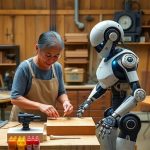In the last post I spoke about how there will be a brief shiny period of AI solo-unicorns. This post examines what happens beyond that era of high AI valuations, as we enter a world where more companies with tiny AI-empowered teams are are competing with each other.
Big incumbent companies, which benefited from dominating fields which required huge engineering/sales/support teams for success, will see their profits decimated, and will ultimately need to shed headcount to compete. Until robotics catches up to the sophistication of language model, job displacement will be most pronounced in white-collar desk jobs spent moving data around and wrangling forms, workflows, processes, and code- the areas where AI datasets are potentially both largest and most available.
Some business units will remain competitive: they may be structurally hard for AI to compete (e.g. projects which require a lot of iteration between space and time, require high reliability/precision, or have strong regulatory barriers to AI entry). And for these, ironically, profits will increase.
Why? Because their vendors are now lightweight, AI-forward companies with low cost structures, and so vendor pricing will be pushed down along with prices in other industries.
These profitable industries, which previously may have had high cost structures and low profits but now see their costs reduced, will now see a more diverse set of entrants as people come in to explore the profits -many of the new entrants may even be recently laid-off employees from unprofitable businesses, wielding the same AI automation tools which cost their own jobs.
But this is where something magical may start happening: the competition creates a surge of vibrance, creativity, and innovation in a previously neglected field. Areas which were once considered unprofitable and undesirable may become hot and buzzy, as new entrants find ways to specialize to occupy their own small niches in these profitable spaces.
This will be repeated across the market, in thousands of small markets which were previously considered unprofitable and undesirable: As the upstream costs of creating, supporting, and sustaining a business go down, new opportunities open up. A flower shop which may have previously struggled to pay their bookkeeper, answering service, and marketing agency may suddenly find themselves with free cash flow to expand as they replace some of those routine vendor services with AI agents. The bookkeepers and marketers who find themselves competing with AI agents may decide that it makes more sense to start that flower shop, bakery, preschool, or construction firm that they always had been thinking about trying after they made their money.
As the costs of doing business go down, the cost of entry will decrease, and millions of new businesses will spring up in areas which never previously would have supported the sales, marketing, and support costs of running a business. As cost goes down, demand goes up: and demand for new, creative, small businesses will never have been this high.
With low cost structures, people will likely be able to support themselves with micro-businesses, serving small local markets with the attention and care that’s often been missing in our globalized economy. Where previously specialization meant being pigeonholed, it will come to mean a bespoke expertise and reliance on human creativity which can’t be replicated by AI’s breadth-first training. In this new world, specialization and micro-marketing will pay off: craftsmanship and personal pride will return to many roles where they have been lacking.
For much of human history, craftspeople competed for the high-volume products which could support their trade -potters, woodworkers, shoemakers, painters. For over 150 years, centralization and standardization has driven down the costs of commodity products, driving out craftspeople as they couldn’t support their cost structures with human-scale volumes. Marx bemoaned the loss of craftsmanship and pride in the final product as people became part of a massive industrial machine. Now, as opportunities open up for small-scale entrepreneurship and tiny teams are empowered to produce high-quality products, we can expect to see the return of modern craftspeople in the digital post-AI economy.
It’s going to be a bumpy ride, but I’m excited to see the diversity and variety of creation in this chapter ahead.
